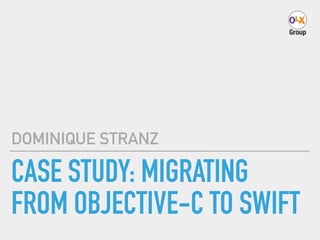Migrating from Objective-C to Swift
- 1. CASE STUDY: MIGRATING FROM OBJECTIVE-C TO SWIFT DOMINIQUE STRANZ
- 2. MIGRATE ? TO SWIFT STAY WITH OBJECTIVE-C ?
- 4. CUI BONO? Lucius Cassius Longinus
- 5. DEVELOPERS
- 7. OPTIONALS
- 8. TUPLES
- 9. STRING ENUMS
- 10. NO MORE ? HEADER FILES
- 12. and so on, ? and so forth¡
- 13. HOW DO? I?START?
- 16. Application new API Client Utils Adopt Nullability Configuration? Manager
- 20. Application new API Client Utils Adopt Nullability Configuration? Manager
- 21. ALL NEW FEATURES WRITTEN ? IN SWIFT
- 22. USE ?TECH DAYS¡± TO MIGRATE ? OBJECTIVE-C CODE ?
- 23. 34% of code in after 2 months
- 26. FILE BY FILE MIGRATION ? IS THE MOST EFFECTIVE WAYChild2 Base Child1 Class2 Class4 Class3
- 27. START WITH ? FILES WITHOUT SUBCLASSES Child2 Base Child1 Class2 Class4 Class3 YOU CANNOT SUBCLASS A SWIFT CLASS IN OBJECTIVE-C
- 28. SWIFT CLASS MUST BE A DESCENDANT OF AN OBJECTIVE-C CLASS? ¡TO BE ACCESSIBLE IN OBJECTIVE-C FILES Child2 Base Child1 Class4 Class3 NSObject
- 29. SWIFT CLASS MUST BE A DESCENDANT OF AN OBJECTIVE-C CLASS? Child2 Base Child1 Class4 Class3 NSObject OBJECTIVE-C WILL NOT BE ABLE TO TRANSLATE CERTAIN SWIFT-SPECIFIC FEATURES
- 30. ? MIXED PROJECTS
- 31. Mix-and-match functionality makes it easy to choose which features and functionality to implement in Swift, and which to leave in Objective-C. Interoperability makes it possible to integrate those features back into Objective-C code with no hassle. Apple Inc. ¡°Using Swift with Cocoa and Objective-C (Swift 3).¡±
- 34. BUNDLE SIZE 22 MB 38 MB YES FOR THE WATCHOS APP NO FOR THE WATCHOS APP EXTENSION Always Embed Swift Standard Libraries ?
- 35. CODE AUTOCOMPLETION FIXED IN XCODE 8.3
- 36. IMPORTS
- 37. IN OBJECTIVE-C HEADER FILES ONLY USE FORWARD DECLARATIONS NSObject @class ClassName; @protocol ProtocolName; IMPORTING A SWIFT HEADER FILE THERE WILL LEAVE YOU WITH A CIRCULAR REFERENCE.
- 38. IF BOTH SWIFT AND OBJECTIVE-C CLASSES ARE IN THE SAME APPLICATION PROJECT NSObject #import "ModuleName-Swift.h"
- 39. IF BOTH SWIFT AND OBJECTIVE-C CLASSES ARE IN THE SAME COCOA POD PROJECT NSObject #import <PodName/PodName-Swift.h>
- 40. IF SWIFT FILE IS ? IN ANOTHER POD NSObject @import PodName;
- 41. IF SWIFT FILE IS ? IN ANOTHER POD NSObject @import PodName; ADD *.SWIFT FILES TO SOURCE_FILES DECLARATION ? IN PODSPEC FILE
- 42. SWIFT CLASS ? IN OBJECTIVE-C
- 43. MUST BE A DESCENDANT ? OF AN OBJECTIVE-C CLASS WILL NOT BE VISIBLE? IN OBJECTIVE-C INT?, INT!, FLOAT?, ¡ SOME NAMES ARE ALREADY IN USE IN NSOBJECT description: String SWIFT CLASSES CANNOT BE SUBCLASSED IN OBJECTIVE-C objc_subclassing_restricted METHODS WITH NIL TERMINATION WILL BE NOT ACCESSIBLE IN SWIFT NS_REQUIRES_NIL_TERMINATION DEALLOC IS UNAVAILABLE ? IN SWIFT, BUT YOU CAN USE DEINIT INSTEAD dealloc != deinit
- 44. SWIFT ENUM ? IN OBJECTIVE-C
- 45. ENUM SHOULD HAVE THE @OBJC PREFIX @objc prefix ASSOCIATED VALUES ? ARE NOT SUPPORTED case variant1(value: Int) IN OBJECTIVE-C ENUM CAN ONLY HAVE INTEGER TYPE @enum Name: Int
- 46. CASE STUDY: MIGRATING FROM OBJECTIVE-C TO SWIFT RawRepresentable enum for ObjectMapper? ? Model should provide wrapper for Obj-C code: ? Translation to enum: Int ? during mapping transformation or in runtime ? Computed property `isActive: Bool`, `is¡: Bool`
- 47. CASE STUDY: MIGRATING FROM OBJECTIVE-C TO SWIFT API Endpoints as URLRequestConvertible enums? ? Create a proxy class (inherited from NSObject) with class requests methods, that inside will use Swift enum ? We decided to only de?ne methods really used by Obj-C? ? ? ? ? ? More about elegant API Endpoints in Alamo?re? https://github.com/Alamo?re/Alamo?re#crud--authorization
- 48. WHAT WILL ? NSCODER ? FAIL TO?SEE?
- 49. CASE STUDY: MIGRATING FROM OBJECTIVE-C TO SWIFT NSCoding ? NSKeyedArchiver, NSKeyedUnarchiver will see only properties visible for Objective-C ? We can change properties type or¡
- 50. CASE STUDY: MIGRATING FROM OBJECTIVE-C TO SWIFT NSCoding ? NSKeyedArchiver, NSKeyedUnarchiver will see only properties visible for Objective-C ? We can change properties type or¡ ? Use value(forUnde?nedKey key: String) -> Any? and setValue(_ value: Any?, forUnde?nedKey key: String)? to set/get not bridged properties ? Example: Use enum¡¯s rawValue as encodable value
- 51. CASE STUDY: MIGRATING FROM OBJECTIVE-C TO SWIFT NSCoding
- 52. CASE STUDY: MIGRATING FROM OBJECTIVE-C TO SWIFT Future? Swift Archival & Serialization proposal ? It aims to provide a solution for the archival of Swift struct and enum types ? It aims to provide a more type-safe solution for serializing to external formats, such as JSON and plist ? Read more: https://github.com/itaiferber/swift-evolution/ blob/swift-archival-serialization/proposals/XXXX-swift- archival-serialization.md
- 54. CASE STUDY: MIGRATING FROM OBJECTIVE-C TO SWIFT enum ServiceError: Error {}
- 55. CASE STUDY: MIGRATING FROM OBJECTIVE-C TO SWIFT enum ServiceError: Error {} ? Error type in Obj-C code? ? NSError without associated values¡
- 56. CASE STUDY: MIGRATING FROM OBJECTIVE-C TO SWIFT enum ServiceError: Error {} ? Error type in Obj-C code? ? NSError without associated values¡ ? CustomNSError protocol: Describes an error type that speci?cally provides a domain, code, and user-info dictionary? ? ? More: https://github.com/apple/swift-evolution/blob/ master/proposals/0112-nserror-bridging.md
- 57. CASE STUDY: MIGRATING FROM OBJECTIVE-C TO SWIFT enum ServiceError: Error {}
- 58. CASE STUDY: MIGRATING FROM OBJECTIVE-C TO SWIFT enum ServiceError: Error {}
- 59. LESSONS LEARNED
- 60. CASE STUDY: MIGRATING FROM OBJECTIVE-C TO SWIFT Optional(?2000 PLN¡±)
- 61. CASE STUDY: MIGRATING FROM OBJECTIVE-C TO SWIFT Optional(?2000 PLN¡±) ? Swift 3.1 will actually actually raise ? a warning when you use an optional ? in string interpolation? ? ? ? ? ? ? More: https://oleb.net/blog/2016/12/optionals-string- interpolation
- 62. CASE STUDY: MIGRATING FROM OBJECTIVE-C TO SWIFT APNS token == ?32bytes¡±
- 63. read more at tech.olx.com
- 64. THANK YOU




























































































